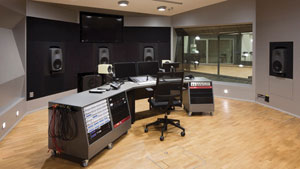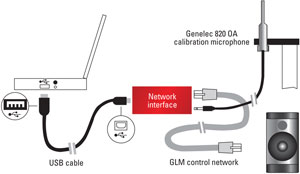Speaker selection is important, but so too is where you place it.
Most of the interest in modern TV broadcasting technology goes into the picture. However, sound is an equally important factor for the user experience, and some of the most important tools for making good sound are audio monitors.
Perhaps a tangible way to describe audio monitoring for TV broadcasting people is to make a comparison with video monitoring. What the video engineer does with color balance is what the audio engineer does with the balance between audio frequencies. Obviously, this does not come as a surprise to many people in our industry. Even so, it seems that those same people have something to learn as we constantly see poor audio monitor installations in the field. This article discusses some of these issues.

When designing a room or studio for audio, the first thing to look for is symmetry, whether it is a surround setting (shown here) or a left and right speaker setup. In a L/R case, the speakers and listening position should form an equilateral triangle.
Once you call something a monitor, it is pretty clear we are talking about some sort of surveillance process. In the case of audio monitoring, it can mean different things. As mentioned above, one meaning, of course, is to control the balance, while another can be to listen and correct inaccuracies or faults. Monitoring also can be both of these together. For example, at the London Olympics International Broadcasting Centre, there were two 5.1 surround rooms where the task was to listen to the 5.1 signal quality just before it went on air. Like the video engineer needs his expensive video monitor with exact colors, the audio engineer needs a tool that is equally exact and reliable in reproducing the audio signal perfectly. A monitoring speaker is a quality-control tool used to judge the technical and artistic quality of the program. This definition is wide, and we next will look at what it means.
Tool keys
The key issues for any tool are reliability, consistency and fitting to the purpose. Reliability means both technical reliability (fault-free operation for a long time) and performance reliability (actual performance does not change in use). Consistency demands that unit-to-unit variation is small between units during the whole lifetime of individual products and production lots. Fitting to the purpose asks for thorough understanding of the conditions where the products are to be used, and what those conditions mean in performance features.
In the market today, we can find a large number of loudspeakers called monitors or reference monitors. Some of them are good, but, unfortunately, not all deserve the name. To be called an audio monitor or a reference monitor, the performance must be known. In short, we need to know the frequency response of the monitor at the listening position. The position is where the sound engineer works.
Some engineers, sadly, think that a manufacturer’s published frequency response in a data sheet is sufficient. Mostly, this is measured in a controlled environment like an anechoic chamber, where there are no mixing consoles, DAWs, flat screens, equipment racks or anything else that has an influence on frequency response. If properly measured, these graphs tell valuable information like distortion, maximum sound pressure level, etc. But, for example, the frequency response measurements have limited value in a real-world environment like a control room. Here, we have one important requirement for a monitoring speaker to fit to its purpose: You must be able to acoustically align it in the room where you will use it. To do so, the monitoring speaker must have the ability to be adjusted, and you need some kind of acoustic measurement tool that can look at the signal in the time and frequency domains. You also need some understanding regarding what the measurements mean.
A real-time analyzer can only give a rough idea, as it measures both direct sound and reflected sound, but does not allow for looking at the signal in time domain. Luckily, there are several software programs available that turn a laptop and good microphone into a proper measurement device.
Speaker placement
How should speakers be placed in a room, and what happens to the sound after it has left the speaker? When setting up a stereo pair of monitors, the first thing to look for is symmetry in the room and symmetry between the speakers and listening position. The distance between your two monitors should be the same as the distance between each one of the monitors and your listening position. This forms an equilateral triangle with 60º corners. Standing behind the left monitor and looking towards your listening position, you should see a similar view as when standing behind the right monitor. If there are different objects or different distances to side or rear walls or other objects (like large screens of your DAW), it will be impossible to achieve a similar response from the monitors. This causes imaging to suffer. The advice is to make sure that you have no reflecting objects between the monitors and your ears, which allows the acoustical audio path to be clean.
Most acoustical phenomena are related to wavelength, i.e. sound pitch. The higher the pitch, the shorter the wavelength and the easier it is to control. The direction where the sound goes from the speaker also depends on the wavelength. That said, it depends, actually, on how large the speaker is in relation to the wavelength. A 20Hz tone has a wavelength of 17m.
At 200Hz, it is still 1.7m. At 2000Hz, it measures 170mm, and at 20000Hz, it will be 17mm. Low frequencies spread all directions, moving as much forward as backward. At mid and higher frequencies, the speaker starts to direct the sound. This can be beneficial as we get more sound to the listener and less to room surfaces.
However, as low frequencies spread in all directions, walls also amplify them. Check this out by standing against a hard wall and talking out in the room. You can hear that your voice gets amplified. This amplification comes from the fact that low frequencies reflect from the hard wall, and the wall becomes a second sound source. When it coincides with the direct signal, the result will be approximately 6dB stronger.
Naturally, the same thing happens when you put a loudspeaker next to a hard wall. If you put the speaker in a corner, then you will have two reflecting surfaces and, thus, a pair of second-sound sources and a boost of 12dB. This can be both good and bad. It is good in the sense that less power is needed for a strong bass reproduction. But, it is bad in the sense that tonal balance will change unless corrected. Here, again, comes the need to adjust the speaker response in the room. It is necessary to correct the room boost in order to get neutral reproduction.
Surround sound
So far, we have talked about stereo only. As you can imagine, these problems become even more complex in a surround sound set up with five or seven speakers and one or two subwoofers. Still, the same guidelines apply: Look for symmetry, and keep the same distance.
There are two approaches to aligning speakers to the room. The frequency response can be adjusted with a few dipswitches controlling the active crossover, with carefully selected frequency ranges.

Setting up loudspeakers to match a room doesn’t need to be complex. A laptop and calibrated microphone can be used to configure a loudspeaker equalizer.
Or, the second approach is to use a digital signal processor built into the loudspeaker to take care of both the room response measurement and speaker acoustic alignment. This simplifies the whole acoustic calibration so that anyone with a bit of computer literacy is able to acoustically align his own monitors — be it a stereo pair or a much more complex surround system. A well-calibrated and acoustically aligned monitoring system will absolutely make any audio engineer’s life a lot easier, as guesswork can then be eliminated.
Rooms
So far, we have been talking about the audio monitor, but not so much about the room where you are going to use it. Again, the spread is wide. There are good rooms, especially in the post-production arena. But, unfortunately, there are also a large number of rooms with little or no acoustic treatment whatsoever. It shall be emphasized that an acoustically well-designed room is as equally important towards good sound as the monitoring speakers themselves.
Unfortunately, it becomes more and more rare that studio designers are used to design these spaces. Often, the work is done in normal office rooms, and many times an interior designer has been involved with no knowledge of audio or acoustics. They design lovely looking rooms with one, two or more walls of glass. Glass is a highly reflective surface for a wide frequency range. But, from an aesthetic standpoint, it is impossible to use any kind of acoustic treatment as the rooms are designed to look into.
We have found that audio monitors equipped with automatic calibration can be a great help in dealing with difficult acoustic spaces. Another difficult application area is OB vans, where such products are becoming increasingly popular as problem solvers.
Adjustable monitoring loudspeakers can be calibrated and acoustically aligned in your room for flat frequency response and neutral sound. The monitor shall be true to the original signal, and not add nor subtract anything from it.
—Ilpo Martikainen is the founder of Genelec. Lars-Olof Janflod is marketing & public relations director, Genelec.
Get the TV Tech Newsletter
The professional video industry's #1 source for news, trends and product and tech information. Sign up below.
